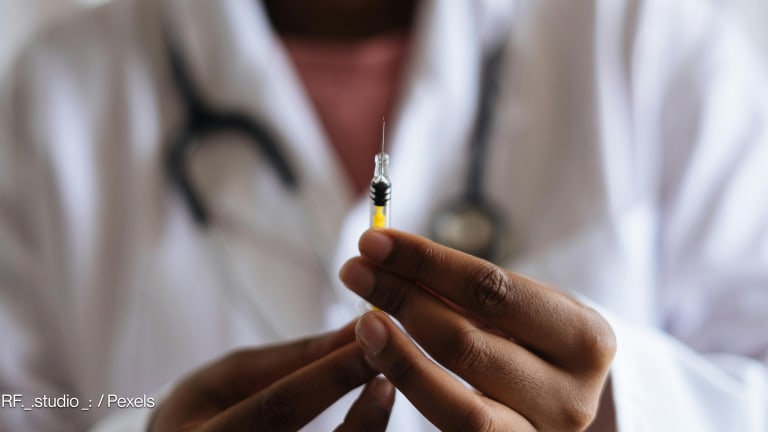
While the global HIV/AIDS community has made great strides toward the Joint United Nations Programme on HIV/AIDS’ 90-90-90 goals and the U.S. President’s Emergency Plan for AIDS Relief’s epidemic control goals, there is still a long journey ahead to end the AIDS epidemic by 2030.
Critical to the global HIV/AIDS community’s efforts is ensuring people living with HIV have access to the latest antiretroviral drugs that effectively suppress viral load. Suppressing viral load can help people live longer and healthier lives, prevent mortality and opportunistic infections like tuberculosis, and minimize transmission of HIV to uninfected partners or during pregnancy.
“We need to get better — and faster — at bringing new treatment regimens to the patients who need them.”
— Nagesh Borse, acting director for the HIV/AIDS task order on GHSC-PSM, Chemonics InternationalFortunately, clinical advancements have given rise to new, more effective medicines with less severe side effects. However, once a new medicine is tentatively approved by a drug regulatory agency — the U.S. Food and Drug Administration, for example — bringing it to market at a global scale is highly complex, particularly in low- and middle-income countries.
In the U.S. it takes approximately five years to transition to a new drug. In Africa, it can take 10 to 20 years to get more than 80% of the population onto a new medication. We need to get better — and faster — at bringing new treatment regimens to the patients who need them.
Lessons from a recent transition
In 2017, when the U.S. FDA approved the currently preferred first-line ARV, tenofovir disoproxil fumarate, lamivudine, and dolutegravir — or TLD, it was a critical milestone promising HIV treatment that is easier, safer, and more effective for tens of millions of people.
PEPFAR leadership took quick action and directed its country programs to transition to TLD so affected communities could quickly reap its benefits. The USAID Global Health Supply Chain Program-Procurement and Supply Management project, or GHSC-PSM, played a pivotal role managing the supply-chain implications of this transition by coordinating with key stakeholders at a global and local level.
With potential new HIV treatment options on the horizon — such as tenofovir alafenamide, injectable ARV therapy, or broadly neutralizing monoclonal antibodies — several lessons from the recent TLD transition will be critical for the global HIV/AIDS community involved in future global medicine transitions:
1. Work with key stakeholders to prepare an enabling environment
Transitioning to a new drug requires coordination with a range of in-country stakeholders and the engagement of all parts of a country’s health system. Supply-chain managers must confirm the availability of active pharmaceutical ingredients; work with host governments to forecast demand; adapt global treatment guidelines to the country; monitor manufacturer registration; assess and reduce import lead times; ready transport systems and storage at every level; and manage the disposal of legacy ARVs.

Planning and continually monitoring the plans are essential. Thus far, GHSC-PSM has worked with USAID and 20 host governments to develop a transition strategy in advance, including information about TLD, guidance about how to prepare for its introduction, a TLD forecasting tool to calculate — and continue to model — how much of the drug would be needed, warehousing and distribution plans to accommodate the new drug, and guidance on disposal of legacy stock.
Throughout implementation, GHSC-PSM works with host governments and suppliers to monitor the plan, track fluctuating demand for TLD, and address bottlenecks. For example, in Botswana, when the National Antiretroviral Treatment Costing and Forecasting Technical Working Group — charged with monitoring the TLD transition — detected an unexpected lag, it asked GHSC-PSM to assess the causes and provide an estimate of the current uptake level in the country. Findings from the assessment allowed GHSC-PSM and other stakeholders to address bottlenecks and course correct to expedite patient uptake of TLD.
2. Coordinate and continuously monitor supply and demand
A successful transition requires careful, coordinated supply and demand planning. Predicting demand is challenging during the transition phase — clinical care providers might delay switching patients to the new regimen if patients are doing well on an existing regimen or they don’t know enough about the new drug’s superior benefits.
Supply of a new regimen is also unpredictable. Suppliers, unsure of global demand, could cause schedule delays, and manufacturing systems take time to come fully online. Supply-chain actors play a key role in assessing and aggregating demand, sharing country requirements with global procurers and manufacturers, negotiating pricing agreements with suppliers, and planning for adequate and well-located global inventory so the supply-chain can respond quickly to needs.
With demand threatening to outstrip supply in late 2017, GHSC-PSM aggregated demand across countries and placed advance orders with manufacturers. This provided manufacturers with the certainty they needed to calculate manufacturing capacity, procure raw materials, and produce to scale before individual countries placed orders. According to our research, which is set to publish in the coming months, as of July 2019, 87% of PEPFAR-supported sites in seven countries — Botswana, Haiti, Malawi, Mozambique, Nigeria, Uganda, and Zambia — reported the availability of TLD.
3. Engage and socialize the new medicine early on for timely uptake
After a long journey from a manufacturing center, medicines reach the local facility and move from trucks and cartons into the patient’s hands. This small, but important, transaction shifts the operational focus from global and national plans and actions to local leadership and capacity. New challenges can arise, such as the lack of information and training for clinicians and other treatment partners, leading to their reluctance to follow national treatment guidelines for the new medicine.
To counter this, clinicians should be engaged early to learn about the benefits of the latest medicines, the anticipated timing of the switch from legacy medicines, and the plans that are in place to manage the inventory and distribution once medicines arrive. Governments and local organizations at district and local levels should develop advocacy and socializing strategies and engage with civil society and patient groups to gain buy-in and promote rapid uptake of the new medicine.
Efforts at the community level require coordination with the government that issues clinical guidance, local community groups or clinical partners that train clinicians, clinicians who sensitize patients and manage prescriptions, laboratories that handle lab tests, and the supply chain that provides the medicine. If any of these is out of step, the transition can be delayed.
Ideally, responsibility is given to a specific group to convene all stakeholders, monitor schedules, and encourage uptake of the new medication. For example, in Haiti, the Ministry of Health took a grassroots approach visiting individual communities early on, meeting with health facility staff, and requiring health training providers in all 10 of Haiti’s regions to take a month-long training on the ministry of health’s new protocols and guidance. After only five months into the transition process, 123 of 126 health facilities supported by PEPFAR were fully stocked with TLD — comprising more than 97% of all PEPFAR-funded health facilities in the country.
We’re in this together
As new medicines continue to be introduced, we must also accelerate the transition of patients living in LMICs to new and more effective drugs. To do so, health stakeholders must work together at the global, national, and health facility levels to prepare, coordinate, communicate, and achieve successful — yet complex — treatment transitions. Supply-chain stakeholders can help manage this process by following these lessons to minimize risk. It is only by being prepared and working together that we can hope to eradicate the AIDS epidemic and other diseases for good.
For more information about the transition to TLD and GHSC-PSM’s work to support its introduction, including country-specific stories, please click here or reach out to TLDinfo@ghsc-psm.org.






